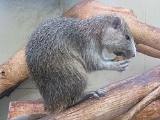
Hystricognathi
Encyclopedia
Hystricognathi is an infraorder of rodent
s. Hystricognaths are distinguished from other rodents by the bone
structure of their skull
s. The masseter medialis (a jaw muscle) passes partially through the infraorbital foramen
and connects to the bone on the opposite side. This, together with their lack of an infraorbital plate and the relative size of the infraorbital foramen
, distinguishes hystricognaths from other rodent groups.
There are 18 families
within the Hystricognathi, divided into two infraorders, the Phiomorpha
and the Caviomorpha
. The Caviomorpha are mostly native to South America
, with a few species in North America
, while the Phiomorpha occur in the Old World
.

Rodent
Rodentia is an order of mammals also known as rodents, characterised by two continuously growing incisors in the upper and lower jaws which must be kept short by gnawing....
s. Hystricognaths are distinguished from other rodents by the bone
Bone
Bones are rigid organs that constitute part of the endoskeleton of vertebrates. They support, and protect the various organs of the body, produce red and white blood cells and store minerals. Bone tissue is a type of dense connective tissue...
structure of their skull
Skull
The skull is a bony structure in the head of many animals that supports the structures of the face and forms a cavity for the brain.The skull is composed of two parts: the cranium and the mandible. A skull without a mandible is only a cranium. Animals that have skulls are called craniates...
s. The masseter medialis (a jaw muscle) passes partially through the infraorbital foramen
Infraorbital foramen
Above the canine fossa is the infraorbital foramen, the end of the infraorbital canal; it transmits the infraorbital artery, vein, and infraorbital nerve.-External links: *...
and connects to the bone on the opposite side. This, together with their lack of an infraorbital plate and the relative size of the infraorbital foramen
Infraorbital foramen
Above the canine fossa is the infraorbital foramen, the end of the infraorbital canal; it transmits the infraorbital artery, vein, and infraorbital nerve.-External links: *...
, distinguishes hystricognaths from other rodent groups.
There are 18 families
Family (biology)
In biological classification, family is* a taxonomic rank. Other well-known ranks are life, domain, kingdom, phylum, class, order, genus, and species, with family fitting between order and genus. As for the other well-known ranks, there is the option of an immediately lower rank, indicated by the...
within the Hystricognathi, divided into two infraorders, the Phiomorpha
Phiomorpha
The rodent parvorder or infraorder Phiomorpha comprises several living and extinct families found wholly or largely in Africa. Along with the Anomaluromorpha and perhaps the †Zegdoumyidae, they represent one of the few early colonizations of Africa by rodents....
and the Caviomorpha
Caviomorpha
Caviomorpha is the rodent infraorder or parvorder that unites all South American hystricognaths. It is supported by both fossil and molecular evidence.-Origin:...
. The Caviomorpha are mostly native to South America
South America
South America is a continent situated in the Western Hemisphere, mostly in the Southern Hemisphere, with a relatively small portion in the Northern Hemisphere. The continent is also considered a subcontinent of the Americas. It is bordered on the west by the Pacific Ocean and on the north and east...
, with a few species in North America
North America
North America is a continent wholly within the Northern Hemisphere and almost wholly within the Western Hemisphere. It is also considered a northern subcontinent of the Americas...
, while the Phiomorpha occur in the Old World
Old World
The Old World consists of those parts of the world known to classical antiquity and the European Middle Ages. It is used in the context of, and contrast with, the "New World" ....
.

Behavior
Play behavior has been observed in seven hystricognath families. The caviomorphs chase each other, play-wrestle, and gallop. The longer-legged species chase more often than the shorter-legged species. They also rotate their heads and body muscles as a form of play (Fagen 1981).Phiomorphan hystricognath familiæ
- Bathyergidae (African mole rats)
- Hystricidae (old world porcupines)
- Petromuridae (dassie rat)
- Thryonomyidae (cane rats)
Caviomorphan hystricognath familiæ
- Abrocomidae (chinchilla rats)
- Capromyidae (hutias)
- CaviidaeCaviidaeThe cavy family is a family of rodents native to South America, and including the domestic guinea pig, wild cavies, and the capybara, among other animals...
(guinea pigs, wild cavies, and capybaras) - ChinchillidaeChinchillidaeThe family Chinchillidae contains the chinchillas, viscachas, and their fossil relatives. They are restricted to southern and western South America, often in association with the Andes. They are large rodents, weighing from to , with strong hind legs and large ears...
(chinchillas, viscachas, and their fossil relatives) - Ctenomyidae (tuco-tucos)
- DasyproctidaeDasyproctidaeDasyproctidae is a family of large South American rodents, comprising the agoutis and acouchis. Their fur is a reddish or dark colour above, with a paler underside. They are herbivorous, often feeding on ripe fruit that falls from trees...
(agoutis and acouchis) - DinomyidaeDinomyidaeDinomyidae was once a very speciose group of South American hystricognath rodent, but now contains only a single living species, the Pacarana. The Dinomyidae included among its ranks the largest rodents known to date, the bison-sized Josephoartigasia monesi and the smaller Josephoartigasia magna...
(pacaranas and their fossil relatives) - Echimyidae (spiny rats)
- Erethizontidae (new world porcupines)
- Myocastoridae (coypus)
- OctodontidaeOctodontidaeThe Octodontidae are a family of rodents, restricted to south-western South America. Thirteen species of octodontid are recognised, arranged in nine genera. The best known species is the Degu, Octodon degus....
(13 species including the deguDeguThe degu is a small caviomorph rodent that is endemic to central Chile.It is sometimes referred to as the brush-tailed rat, and is also called the common degu, to distinguish it from the other members of the genus Octodon. Other members are also called degus, but they are distinguished by...
)
External links
- http://animaldiversity.ummz.umich.edu/site/topics/mammal_anatomy/rodent_jaws.html

